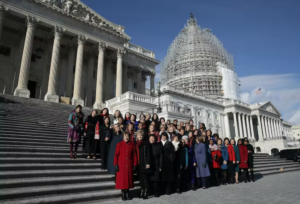Just Over 1 in 4 Members of Congress in 2023 Will Be Women – At This Rate, It Will Take 118 Years Until There Is Gender Parity
When the 118th Congress convenes on Jan. 3, 2023, the number of women among its 535 members will inch up by just two – increasing from 147 in 2022 to 149 in 2023.
Even though more women than men voted in the the 2022 midterm elections, women’s representation in Congress, with a total of 535 members, will then stand at just 27.9%.
At this rate, it will take 118 more years – until 2140 – for there to be an equal number of male and female lawmakers in Congress.
The slow progress of women in elective office is frustrating for some political observers and experts – including myself – who believe that achieving gender equality in Congress is an important goal.
I am a political science scholar who has spent 20 years researching the reasons for women’s underrepresentation in elected office in the United States.
This issue is important because how many women there are in the room when legislative decisions are made has significant consequences for the policies that governments enact. Female legislators are more likely than men to introduce, speak about and work to pass policies that disproportionately affect women and girls, such as paid family leave, pay equity and gender-based violence.
Having more women in Congress also strengthens female voters’ sense of connection with the government. It also bolsters women’s sense that government cares about their concerns and inspires young women to become more politically engaged.
What’s behind this sluggish pace
While women are underrepresented in governments around the globe, it is a particularly significant problem in the United States. Currently, the U.S. ranks 73rd in the world when it comes to female representation in government.
But the reason women are so dramatically underrepresented in U.S. government is not because they face resistance from voters or struggle to raise money. On the contrary, decades of research shows that when women run, they raise as much money and win as often as similarly qualified men.
In my 2021 book, “The Partisan Gap,” I show that the slow progress of women in politics is a tale of two political parties.
In the next Congress, there will be 107 female Democratic lawmakers and 42 female Republican lawmakers in the Senate and House combined.
In other words, Democrats will compose 72% of the women in Congress. Despite Democrats losing nine congressional seats during the November 2022 midterms, the number of Democratic lawmakers in Congress who are women will remain steady.
The gap between elected Republican and Democratic female lawmakers in Congress has widened over the past four decades.
Are You Ready to Lead?
Our Spring Training Workshop series has everything you need to prepare.
